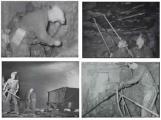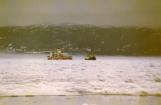1
In 1935, over 6000 people lived and worked on Bell Island. A miner's job was a dangerous one and accidents occurred on a regular basis. In the early 1900s the high number of accidents occurring in the mines could be correlated directly to the lack of safety regulations in place. In 1906 the "Regulation of Mines Act" was introduced which was responsible for the appointment of inspectors and investigators.3
In 1924, a safety committee looked into the type of accidents that took place in the mines and they found that the most common type of accident happened through the carelessness of the injured party. Depending on the type and severity of the injury, the patient was either treated on the island or transported by boat to the larger centres in St. John's.5
During the summer months it was easy to get people across the tickle by boat but the winter months caused many headaches among the residents and mining company on Bell Island.It was not uncommon for the waters surrounding the island to freeze up, making a ferry crossing impossible. Without their own hospital, severely ill or injured patients stranded by the ice were not able to receive treatment in a timely fashion.


